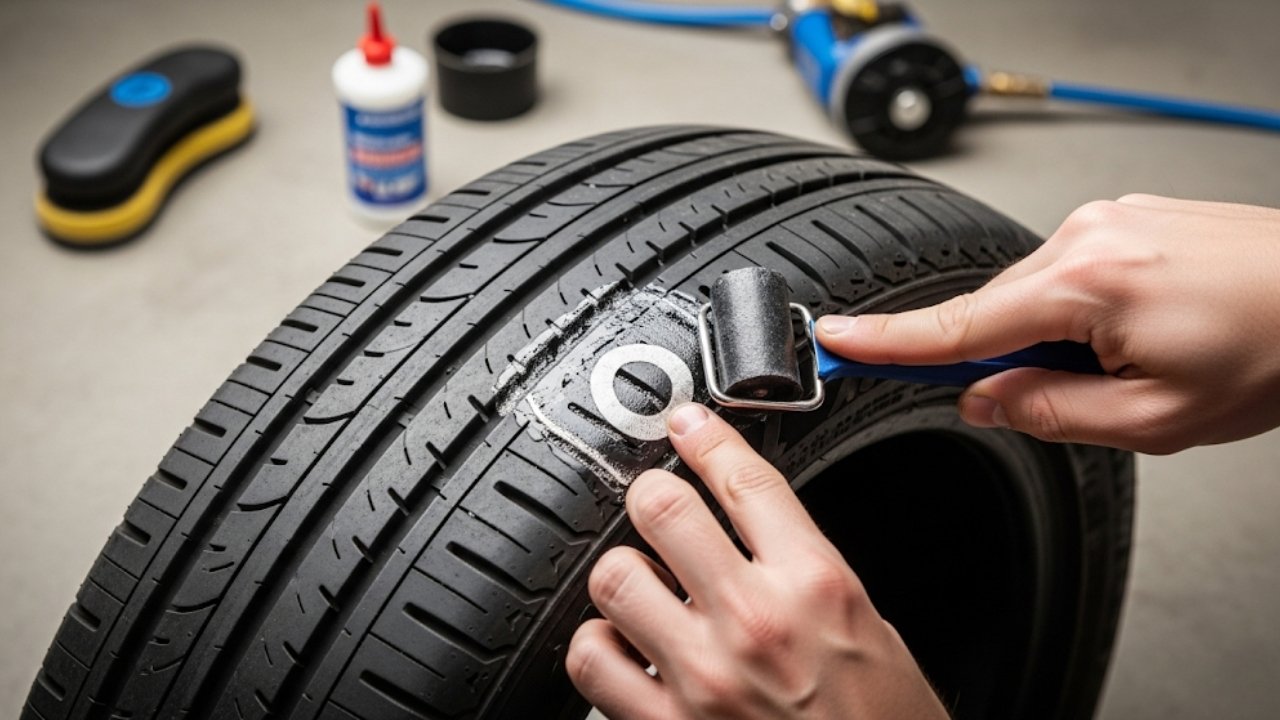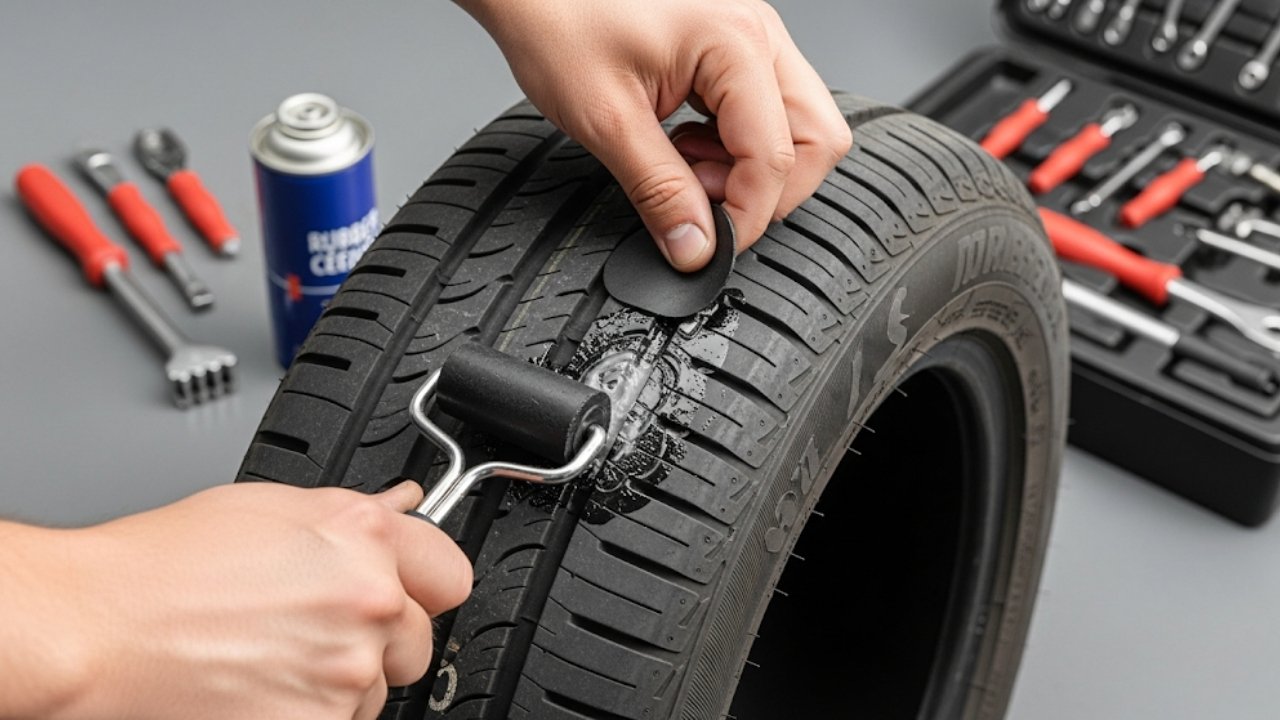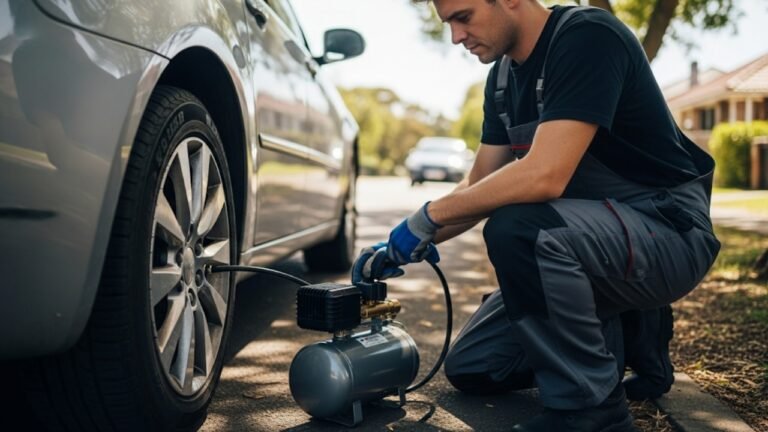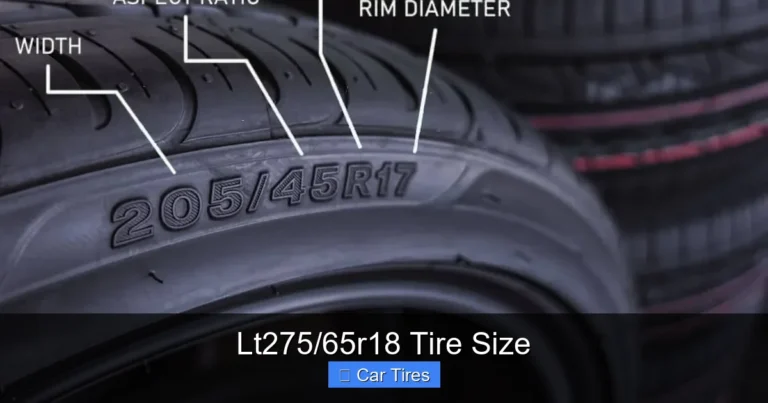Can a Tire Be Patched?

Have you ever walked out to your car, full cup of coffee in hand, only to see one tire looking a little… sad? That slow sag, the deflated look—it’s enough to flip your mood upside down. I’ve been there. Trust me, it feels like the universe has paused just to mess with your day. But before you start Googling new tires or calling a tow truck, you might wonder: can a tire be patched?
That simple question can save you time, money, and a whole lot of frustration. In this article, we’ll explore whether your tire can be patched, when it’s safe, when it’s not, and everything in between. Think of this as your ultimate guide, like that helpful friend who’s good with cars and always gives you the real scoop.
We’ll dive deep but keep it light, relatable, and—most importantly—clear. Let’s roll.
In This Article
- 1 What Does It Mean to Patch a Tire?
- 2 When Can a Tire Be Patched Safely?
- 3 When Should You Avoid Patching a Tire?
- 4 How Is a Tire Patched? (Step-by-Step Process)
- 5 Cost of Patching vs. Replacing a Tire
- 6 Pros and Cons of Patching a Tire
- 7 Patch, Plug, or Sealant? Which One Should You Trust?
- 8 Cultural Insight: How Different Regions Handle Tire Repairs
- 9 Tips to Prevent Tire Damage in the First Place
- 10 Real Story: The 2 AM Puncture That Taught Me Everything
- 11 Frequently Asked Questions (FAQs)
- 11.1 ❓1. Can a tire be patched twice?
- 11.2 ❓2. Is it safe to drive long distances on a patched tire?
- 11.3 ❓3. Can a tire be patched on the sidewall?
- 11.4 ❓4. Is plugging or patching better?
- 11.5 ❓5. How long does it take to patch a tire?
- 11.6 ❓6. Will patching void my tire warranty?
- 11.7 ❓7. Does tire sealant affect future patching?
- 11.8 ❓8. Can run-flat tires be patched?
- 12 Final Thoughts: Safety, Savings, and Smart Choices
What Does It Mean to Patch a Tire?

A tire patch is exactly what it sounds like: a piece of rubber used to seal a puncture from the inside of the tire. When done right, it creates a strong, airtight bond that keeps the tire inflated and safe to drive.
There are generally two types of repairs:
-
Plug: Inserted from the outside, quick and often temporary.
-
Patch: Applied from the inside, usually more durable and long-lasting.
A patch can last years—even for the life of the tire—if installed correctly. But here’s the kicker: not every tire can be patched. And that’s where the “honest truth” part comes in. It depends on where the damage is, how big it is, and even how long you’ve been driving with it.
Real Talk:
When I had my first flat on a dusty highway outside of Dhaka, I didn’t even know tires could be patched. I spent hours waiting in the heat for roadside help, only to be told I could’ve patched it for 300 taka instead of buying a new tire. Lesson learned.
When Can a Tire Be Patched Safely?
Alright, here’s the golden question: can a tire be patched safely?
Yes—but only under the right conditions. It’s kind of like deciding whether to fix a torn shirt or buy a new one. If the rip is small and in the right spot, sewing it up works just fine. But if it’s shredded at the seams, no tailor can save it.
Here’s when it’s usually safe to patch a tire:
-
The puncture is ¼ inch (6mm) or smaller
-
The damage is in the tread area
-
There are no bubbles, sidewall cuts, or belt separation
-
You haven’t driven far on a flat (which can damage the internal structure)
✅ Quick Checklist:
| Condition | Safe to Patch? |
|---|---|
| Hole in center tread | ✅ Yes |
| Cut on sidewall | ❌ No |
| Tear longer than ¼ inch | ❌ No |
| Nail or screw puncture in tread | ✅ Yes |
| Previous patch already done | ⚠️ Maybe |
| Run-flat driven too long | ❌ No |
If all the safe boxes are ticked, then you’re in luck! A tire patch is not only possible—it’s a smart, cost-effective solution.
When Should You Avoid Patching a Tire?
This is where things get serious. Just like you wouldn’t slap duct tape on a leaking gas pipe, patching the wrong kind of damage can be dangerous.
Here’s when you should NOT patch a tire:
-
Sidewall damage – This part flexes a lot while driving. A patch here won’t hold.
-
Large gashes or tears – Bigger than ¼ inch? It’s unsafe.
-
Punctures near the shoulder – That curved edge between the tread and sidewall is tricky and patching it won’t last.
-
Internal structural damage – If the belts or plies are separated, no patch will fix it.
-
Run-flat tires – Often, once these are deflated, they’re done.
I once tried to save money by patching a sidewall cut on a friend’s old sedan. It lasted two days before blowing out on the expressway. Not only scary but incredibly risky.
Remember, tires carry the weight of your life—literally. Don’t gamble with safety for a quick fix.
How Is a Tire Patched? (Step-by-Step Process)
Okay, you’ve confirmed the damage is minor and patchable. Now, let’s walk through how the patching process works. Think of it like a doctor stitching up a clean cut—it’s precise, careful, and done right in a clean shop.
Step-by-Step Guide:
-
Remove the Tire: The wheel is taken off your vehicle and deflated.
-
Inspect the Damage: The tech checks for inner damage you can’t see from outside.
-
Buff the Area: The inside of the tire is roughened to help the patch stick.
-
Apply Rubber Cement: Sticky stuff helps bond the patch permanently.
-
Press the Patch: A mushroom-shaped patch is pressed inside the tire.
-
Cure and Seal: It’s left to set for a few minutes to ensure a tight seal.
-
Test the Repair: Air is pumped in and the tire is checked for leaks.
Done right, a patched tire can go tens of thousands of kilometers with zero issues.
Cost of Patching vs. Replacing a Tire
Ah, the money part. One of the main reasons people ask can a tire be patched is to save cash. And honestly? That’s smart.
Price Comparison:
| Option | Average Cost (BDT) | Lifespan |
|---|---|---|
| Tire Plug | ৳100–৳300 | Short-term (weeks) |
| Professional Patch | ৳300–৳700 | Long-term (years) |
| New Tire | ৳5,000–৳15,000+ | Full lifespan |
If the damage qualifies, patching is a budget-friendly move that won’t compromise safety. Just make sure it’s done professionally. That corner-shop “roadside patch” guy might not always follow the safest steps.
I once paid a shady garage 200 taka for a quick fix. No inspection, no inside patch—just a plug and a prayer. Guess what? Flat again in three days.
Pros and Cons of Patching a Tire
Sometimes, a quick list says it all. Let’s weigh the real-world pros and cons of patching:
✅ Pros:
-
Affordable
-
Fast
-
Environmentally friendly (fewer tires in landfills)
-
Safe when done right
❌ Cons:
-
Not suitable for all damage
-
Can’t be used on sidewalls or shoulders
-
Improper patching = high risk
-
Some shops push for replacement even when patching is possible
A balanced approach? Use patches wisely, and know when to say no.
Patch, Plug, or Sealant? Which One Should You Trust?
Let’s face it: when your tire goes flat, every second counts. You’re likely standing on the side of a busy road, checking your phone, hoping for a quick fix. That’s when you remember those repair kits or that gooey sealant bottle in your trunk.
But here’s the big question—what’s the best option? Let’s compare:
| Repair Type | Pros | Cons | Best For |
|---|---|---|---|
| Plug | Quick, cheap, no tire removal | Temporary, riskier if done wrong | Small tread punctures |
| Patch | Long-lasting, safe, professionally done | Needs tire removal, takes longer | Most tread punctures |
| Sealant | Easy DIY, good in emergencies | Messy, often clogs TPMS, not permanent | Emergency situations only |
If you’re asking “can a tire be patched” and weighing it against these two, patching wins for long-term safety. Plugs and sealants are quick fixes, but patches are like getting stitches at a clinic instead of putting a band-aid on a deep cut.
I used tire sealant once on a rainy night—worked for two days, then the tire slowly lost pressure again. Had to get it professionally patched anyway. Lesson? Use sealants only when you must, not as your main solution.
Cultural Insight: How Different Regions Handle Tire Repairs
Where you live can change how you fix a tire. In rural Bangladesh, a flat tire might be met with a roadside vulcanizing shop that’s been around for decades—where a mechanic uses a flame torch and rubber strips to plug the hole. In the U.S., you’d likely head to a chain like Firestone for a certified patch.
In urban South Asia, plug repairs dominate because they’re fast and cheap. But in Europe, regulations often forbid plugging for safety reasons unless done professionally.
So, can a tire be patched? It depends on where, not just how.
This also highlights why understanding patching from a global and local lens is important. What’s “normal” in your hometown might be frowned upon elsewhere. But at the end of the day, safety should be the universal language.
Tips to Prevent Tire Damage in the First Place
Wouldn’t it be better if you never had to patch your tire at all? While no one can control every nail or pothole, a little prevention goes a long way.
️ Smart Prevention Tips:
-
Check tire pressure weekly. Under-inflated tires are more prone to damage.
-
Avoid driving near construction zones. These areas are landmines for screws, nails, and debris.
-
Inspect your tires regularly. Look for bulges, cuts, or embedded objects.
-
Rotate your tires every 8,000–10,000 km. This keeps wear even.
-
Don’t overload your car. Too much weight increases stress on your tires.
I once skipped tire checks for months until I found a rusted nail buried deep in the tread during a random car wash. No warning light, no visible loss of air. That tire could’ve blown out at highway speed. Scary, right?
Prevention doesn’t take long—but it can save your life.
Real Story: The 2 AM Puncture That Taught Me Everything
Let me tell you a story. It was a rainy night, around 2 AM. I was driving back from a wedding, suit still on, music playing softly. Then I heard that unmistakable “thup-thup-thup” sound. Flat tire. Dead flat.
I pulled over, drenched from the rain, headlights dim in the distance. With no spare and no idea how to use sealant, I called a mechanic friend. He came in 30 minutes, patched the tire from the inside—right there on the roadside, using a portable tire machine. It cost me 500 taka, a few laughs, and a memory I’ll never forget.
That night taught me this: can a tire be patched? Absolutely. Should you know how, when, and where? 100% yes.
Frequently Asked Questions (FAQs)
❓1. Can a tire be patched twice?
Yes, but only if the patches are far apart (at least 16 inches) and both are in the tread area. Two or more patches near each other or on the same side could weaken the tire’s structure.
❓2. Is it safe to drive long distances on a patched tire?
Absolutely! A professionally patched tire can last for tens of thousands of kilometers, sometimes even for the rest of the tire’s life.
❓3. Can a tire be patched on the sidewall?
No. The sidewall flexes too much, and patches won’t hold. Any sidewall damage usually means tire replacement.
❓4. Is plugging or patching better?
Patching is far better for long-term safety. Plugs are temporary and best only for minor punctures caught quickly.
❓5. How long does it take to patch a tire?
About 15 to 30 minutes at a professional repair shop, depending on tools and skill.
❓6. Will patching void my tire warranty?
It depends on the brand. Some manufacturers honor warranty if repairs are done professionally. Always check with your tire provider.
❓7. Does tire sealant affect future patching?
Yes. Some sealants make it harder to clean the inner lining of the tire, which can reduce patch effectiveness.
❓8. Can run-flat tires be patched?
Some manufacturers allow patching run-flats, others don’t. If you drove on it while flat, patching may no longer be safe.
Final Thoughts: Safety, Savings, and Smart Choices
So, let’s come back full circle to our question: can a tire be patched?
Yes. But not always. And not everywhere on the tire. When done right—professionally, safely, and under the right conditions—a patch can be your tire’s second chance at life. It’s cheaper than replacement, better than a plug, and far more reliable than tire sealant.
But it also requires a bit of wisdom—knowing when to patch and when to walk away. Think of it like relationships. Some are worth saving, others… well, they’re better left behind.
So, next time you face that saggy tire, you’ll know what to do—and what not to do. Patch when it makes sense. Replace when safety is at risk. And always, always keep a bit of knowledge (and maybe a tire pressure gauge) in your glovebox.






